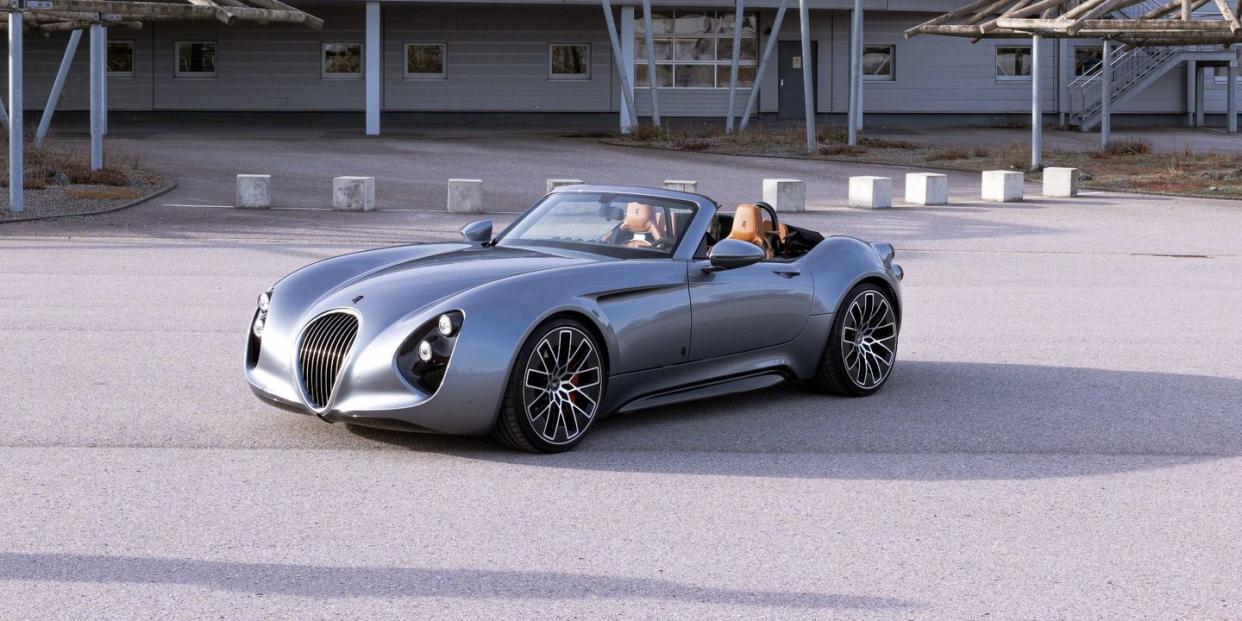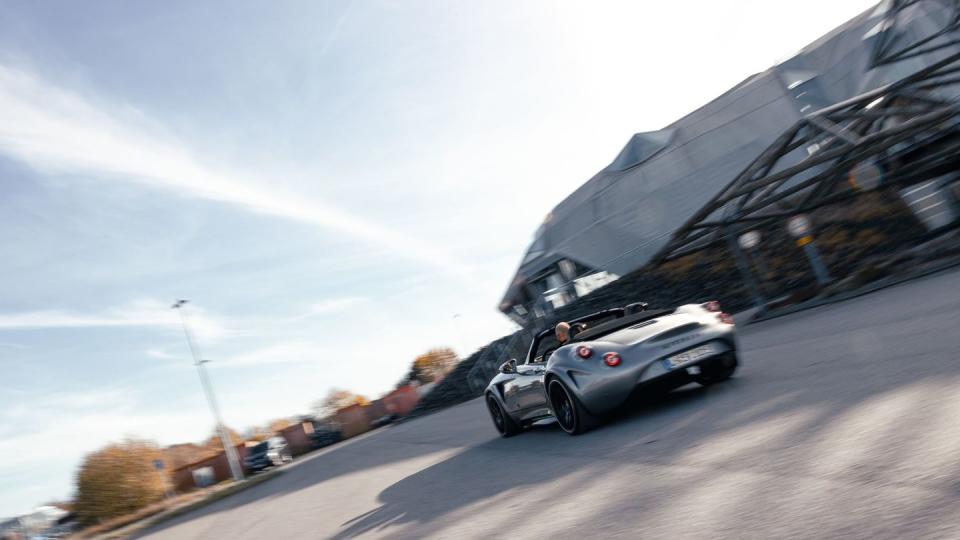Retro EV Roadster Combines Futuristic Tech and Throwback Styling

Weismann carbon-bodied EV roadster dubbed “Project Thunderball” is set to go on sale in 2024.
The production version promises 670 hp, though the as-tested prototype had less. Performance is promised to be quicker than company’s old BMW-powered lineup.
The boutique automaker says the production car will be available Stateside.
Are the best cars bought or built? The long-running debate is set to continue into the electric age. Some enthusiasts are already constructing EV classics using transplanted battery drivetrains, and while some of these conversions are finished to a high standard, others are terrifyingly poor.
There is also going to be another way: buying a brand-new, retro electric sports car. Several big automakers have dropped hints that some of their greatest hits are set to return as modern EVs, but now a small German automaker has got ahead of the pack with its own fully electric roadster. Meet Wiesmann’s “Project Thunderball.”
The company’s name may be familiar. Wiesmann produced a range of muscular coupes and roadsters in the around the turn of the millenium, these combining backward looking design obvious inspired by ’50s and ’60s classics with modern BMW powerplants. Wiesmann never officially sold its cars in the US, although you may well have experienced virtual versions in various video games. The company’s first incarnation went bankrupt in 2013, before being acquired and relaunched by a British-Indian entrepreneur called Roheen Berry.

Berry’s initial instinct was to carry on where the original company had left off, and he funded development of what was set to become a new model powered with a BMW V8 engine. Then Europe’s move towards full electrification prompted a radical change of plan, the future car switched to a fully electric powertrain under the title “Project Thunderball.” The Bond-inspired moniker won’t make production, but even without a final name, Autoweek got the chance to visit Wiesmann’s factory in Dülmen, Germany, to drive a prototype version.
Different bits of Project Thunderball were both closer and further to finished specification. The design is pretty much done, the muscular carbon-fiber body work looking great, and the standard of fit and paintwork high. Styling is less retro than Wiesmann’s earlier offerings, with the striking front graphic combining the traditional radiator grille—here for form rather than function—with a striking masked graphic around the LED headlamps.
For the most part the cabin was similarly impressive, with beautiful stitched leather and an array of apparently analog dials which are actually reporting on the EV powertrain’s temperature and status. There is also a small digital instrument display behind the steering wheel, plus a touchscreen mounted at the base of the central stack. This latter feature was an ergonomic failure, being fiddly to operate and almost impossible to see in direct sunlight. Sadly it controls heating and ventilation settings as well as infotainment; the production car should really be upgraded to some traditional rotary controls.
The seating position is very low for an EV, which is because Project Thunderball’s origins as a combustion project mean its battery is accommodated into the space formerly intended for the car’s V8 engine and transmission. The 92kW T-shaped pack is therefore narrower and considerably taller than an under-floor battery would be, but does mean that the driver’s ass can be kept in close proximity to the ground. Two other details that could benefit from more consideration are the lack of a full cover for the fabric roof when it is folded, leaving much of its structural mechanism on display like a pram, and also the height and visual obviousness of the roll-over hoops behind each seat. (Wiesmann is also working on a coupe version which should address both of these issues.)

Although much about the driving experience felt good, overall it felt some way off being ready for customers. Power comes from a pair of rear-mounted electric motors, with these turning a conventional mechanical limited-slip differential through a shared shaft. Wiesmann says that the production version of the car will boast as impressive 670 hp, with this working against a finished weight of just 1700 kg (3748 lbs). That should enable it to blow through the European 0-60 mph benchmark in a claimed 2.9 seconds, and to blast from rest to 124 mph in just 8.9 secs. But the prototype’s powertrain was short of that level of vigor, with acceleration soon creating the brake-dragging sensation of the motor de-rating as internal temperatures rose.
Even at less than full bore, Project Thunderball was still quick; for much of my drive I was chasing an earlier 407-hp V8-engined Wiesmann MF4, which couldn’t pull out much gap even as its exhaust note hardened. But the MF4’s muscular soundtrack emphasized the prototype’s lack of aural drama, beyond the sound of rushing air and the mechanical whine of its single speed reduction gear it is all-but silent. The lack of drama undoubtedly suited it better than an artificial speaker-produced soundscape would, but it does make for a very different experience for anyone coming from a more traditional sports car.

Powertrain aside, an impressive amount of the dynamic character of earlier Wiesmanns has passed into the electric age. The front-mounted battery gives a similar weight distribution and center of gravity to one of the the company’s V8 powered cars; according to the company, the cell pack is only 50 kg (110 lbs) heavier than the combined weight of an engine and transmission. So it handles like a big-engined roadster, preferring to be turned into a corner at a respectful pace but then happy to be powered to the edge of a rear-axle breakaway. The prototype’s traction control algorithm stepped in hard to prevent any actual sliding, but the benign chassis balance behind this was obvious. Thunderball’s steering is quick but, currently, short on meaningful communication—and the suspension frequently ran out of travel and bottomed-out on compressions; all things that can be easily fixed for production.
The prototype also boasted the unlikely sight of a pair of what looked to be gear-change paddles behind the steering wheel. These actually varied the amount of regenerative braking from the rear motors, with five different settings. Even the strongest of these didn’t produce especially fierce levels of retardation, but choosing it does allow one-pedal operation.
The renamed production version of Project Thunderball will be launched in 2024, with the plan being to sell it in both Europe and the US—Berry committing to undergoing the cost and complexity of full federal-type approval. Pricing will be around the €300,000 mark ($320,000 or so), which doesn’t seem outrageous by the standards of some of the gaudier automotive trinkets the 0.01-percent seem happy to drop their money on. Yes, there is an experiential gap compared to earlier cars—character has been lost in the transition from V8 muscle to silent electric thrust. But Wiesmann deserves credit for pioneering work, and for trying to reach the future early with what is, powertrain aside, a thoroughly traditional sports car.


